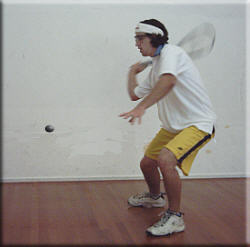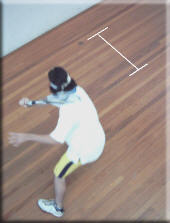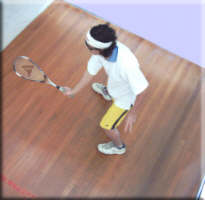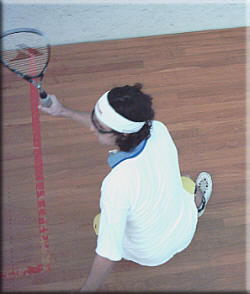Squash Drive

- The squash drive is the basic squash stroke
- Strive to hit straight drives close to the side wall and cross courts wide, to land behind the service box, preferably angling towards the side wall nick.
- The Squash drive or "rail" as it is sometimes known, is a basic tactical stroke
» Approach » Shape » The Stroke » Recovery
Approaching a Drive
More on Approaching the Drive
| ||||||||||||
Shape Before Striking
More on Shaping
|
| Good | Bad |
| Got to the ball early, WAITED - before playing my shot | Kept running and hitting until my opponent made an error. |
| Concentrated at training on what shot options would be possible from the front of the court. | Hit cross court each time I got to the front of the court. |
| Built up an armoury of replies to a drop shot, eg drop, lob, tickle boast. | Try to drive all drop shots to length. |
| Waited till my opponent moved, then hit the ball back to whence they came. | Tried to out hit/run my opponent. |
| Position the body in a way that makes it difficult for the opponent to take off until you have struck the ball | Squeeze around my opponent so I can get a good shot at the ball and mess up the shot. |
The Stroke

- "Set" with the backswing just prior to the stroke.
- Transfer weight as the downswing commences (the hit).
- Keep the procedure as fluent as possible.
More on weight transfer as striking
 Squashgame Gold: Advanced Text and Video Content
Squashgame Gold: Advanced Text and Video Content
More on weight transfer as striking
- As the front foot starts to come down the backswing commences taking the player into the Set position.
- Depending how early the player is for the shot, the set position soon makes way for the hit as the weight of the body transfers from the back to the front foot and the downswing commences.
- Ensure that there is plenty of room to take a full swing at the ball (usually a racket length between the player and the line of the ball.
- Start the racket off on the line of the ball if possible and swing through to the target point.
More about moving while striking the ball
More about moving while striking the ball
- Movement while striking the ball can alter the accuracy of the shot, but increase the power of the shot.
- Forward movement while striking the ball will make it more difficult to recover to the centre of the court after hitting the ball. (Often causing one unnecessary forward step).
Video clip Weight transfer and balance
Weight transfer and balance
In the video back wall rail drive you will see the movement and judgement required to strike the ball accurately, and then regain balance as well as recover to the center court.
- Weight transfer can get players into trouble if the feet are not balanced.
- It is necessary to have a wide base of support to steady the feet.
- If the feet tend to move with the transfer of weight that can make the shot inaccurate, as it pulls the swing out of alignment from the target point, resulting in a lack of balance, which then hinders recovery.
- Lifting of the head at the time of striking the ball can prevent weight transfer.
- Moving off the ball before finishing the follow through can alter the direction of the hit and power of the shot..
- Standing almost cross-legged when attempting to recover to the center court, will hinder the speed of recovery, and prevent smooth movement back to the center court.
- Check that balance is maintained on both the front and back foot (test that out by attempting to swing while having the weight on either leg). This is particularly helpful when the ball juts out quickly or unexpectedly hits the nick.
- It is important to be able to step back towards the center court after striking the ball, as opposed to taking a step forward, then turning around, and moving back.
In the video back wall rail drive you will see the movement and judgement required to strike the ball accurately, and then regain balance as well as recover to the center court.
Video Resources
Recovery after striking the ball

- Follow through to the target.
- Commence recovery immediately.
- Finish follow through near ready position for next return.
More on Recovery to the T
 Squashgame Gold: Advanced Text and Video Content
Squashgame Gold: Advanced Text and Video Content
More on Recovery
- Immediately after racket ball impact, the player should start the process of recovery to the T.
- Throughout the striking process the player should remain balanced and this must be maintained as the backswing is completed and recovery is commenced.
- Ideally, the follow through should finish not far from the ready position for the next return.
More on Video clip Ready to Recovery to the T
Striking the ball when moving into the back corner, and speedy recovery to the center court.
- While recovering to the T (centre court area) keep watching the position of the opponent.
- Be "Ready" to volley or intercept the ball while the opponent is returning to the "T".
- Balanced movement and racket ready.
Video Resources
Support Squashgame
Support us here at Squashgame.info! If you think we helped you, please consider our Squash Shop when purchasing or make a small contribution.
